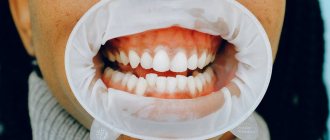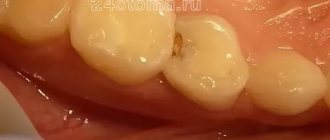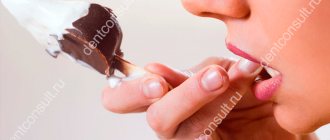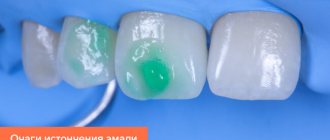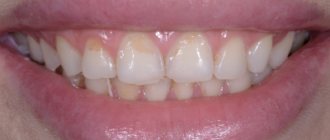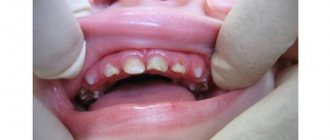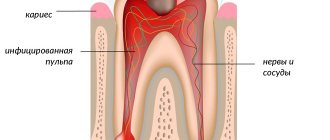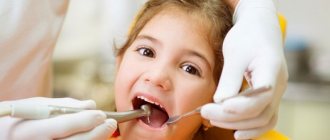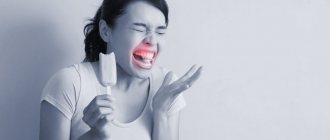Increased tooth wear – This is a process of increased tissue loss: first, the enamel becomes thinner, and then the inside of the teeth. Typically, the process of abrasion is constant - teeth gradually wear out throughout human life: first, the tooth enamel becomes thinner, and in old age it comes to the inner layers. Increased abrasion is a similar process that occurs at an accelerated rate: a real problem, and we will tell you how to deal with it.
The pathological loss of dentin and enamel is different in that it occurs much faster than with normal physiological abrasion. In this case, we talk about abnormal tooth wear, which is a recognized dental problem that mainly affects men over the age of 30. In this case, the decrease in the dental layer begins gradually, and as it progresses, it is no longer possible to influence the disease or cure it. That is why it is extremely important not to miss the initial stage of destruction of tooth enamel - so that tooth extraction, treatment and prosthetics are not required.
Physiology is to blame for everything
To begin with, let's say that all the causes of tooth wear can be divided into two large classes - physiological and pathological.
The first reason appears immediately after the final eruption of baby teeth - and this is a natural process. In children, the incisors, cusps on the canines and molars gradually wear away, and by the age of 6 years, the depth of wear down to the dentin can be observed. In the future, until the age of 14, when the teeth are finally replaced by permanent ones, abrasion of the dentinal layer of the first teeth is sometimes noted. Severe abrasion is diagnosed when the entire upper part of the tooth disappears or the cavity becomes visible.
In general, due to physiological characteristics, teeth adapt to stress during the process of wear. Without dangerous overloads, the work of the entire dental system is adjusted; contacts between teeth change the angle from point to plane, so that the closure of the jaws is more physiological.
If the changes affect only the enamel, there is nothing to worry about. But if dentin begins to participate in the process of abrasion, this is a reason to consult a doctor.
What is tooth enamel abrasion?
The abrasion of tooth enamel, when the protective layer of the organ quickly becomes thinner and the height of the crown decreases, is a pathological disorder. The patient experiences deformation of the bite and teeth. The natural abrasion of enamel, which occurs during life, does not lead to such consequences. The risk group for the disorder includes male smokers and persons who, due to their professional activities, are often forced to come into contact with toxic volatile substances.
Enamel wear by age
The problem of tooth enamel wear is observed in 12% of people. Age affects the intensity of the process, and the degree of manifestation of the disorder increases over the years. Patients under 30 years of age rarely have significant abrasion.
- From 30 to 50 years. More often, only the top layer of enamel is affected, and the dentin tissue is not damaged. The violation does not cause discomfort.
- From 50 to 60 years. The condition of the teeth deteriorates, and dentin is involved in the damage. At the same time, the molars turn yellow or acquire a brownish tint. The shape of the teeth is deformed, and sensitivity is increased.
- After 60 years. The changes especially affect the front teeth. Their tissues become more loose. The height of the crowns decreases.
Degree of tooth enamel abrasion by age
Urgent medical attention is required if teeth wear
occurs before the age of 30. The development of pathology in this case proceeds rapidly.
Process Features
Abrasion of tooth enamel is not just a cosmetic defect. With pathology, due to a decrease in the height of the tooth crown, malocclusion begins to form, and then changes in the structure of the maxillofacial apparatus. Lack of treatment causes the destruction of damaged teeth and their loss.
Also in case of pathology of tooth abrasion
Changes in the skin around the lips are also observed. It becomes covered with small wrinkles. In addition, the lower jaw begins to look smaller, which causes an imbalance in the proportions of the face. Qualified dental care can help you avoid problems.
What causes enamel wear?
The process of reducing the height of the tooth crown and abrasion of the enamel, which is pathological in nature, develops against the background of provoking factors. Internal causes of violation are especially dangerous. The main provocateurs of the problem are:
- congenital defects in the process of development and formation of bone tissue in the body - the disorder may be a consequence of vitamin deficiency in the mother during pregnancy or a deficiency of microelements;
- genetic disorders - usually all bone tissues of the body are affected;
- pathologies of the thyroid gland;
- defects in the process of calcium absorption by the body;
- improper monotonous diet.
Reasons for abrasion of tooth enamel
Smoking, alcoholism, missing teeth and bruxism (strong clenching of the jaws during sleep, which occurs involuntarily) also contribute to dental problems.
Stages of disease development
The process of abrasion of tooth enamel takes place in four stages:
- Minor deformation of the enamel, in which only the incisors are affected. The remaining teeth are unaffected or practically unaffected. The condition does not cause discomfort and can only be detected when examined by a specialist.
- Destruction of the tooth crown down to the dentin. The patient has increased tooth sensitivity. Externally, the destruction is noticeable to a non-specialist.
- Crown wear by half its height or more. Upon examination, a cavity is discovered in the tooth. Pain also occurs without exposure to an irritant.
- Tooth destruction to the base. The hard parts of the tooth crown are completely lost.
The earlier treatment is started, the cheaper it will cost.
Symptoms
If the disease is ignored for a long time, severe symptoms develop. Some patients turn to the dentist only when the discomfort becomes constant and severe. Treatment is required when the following symptoms are present, even to a minor extent:
- high sensitivity of teeth to cold or hot, as well as mechanical stress;
- change in enamel color to dark;
- rough surface of the crown and thinning of the tooth
; - diction disorders;
- difficulty chewing;
- frequent biting of cheeks or lips;
- formation of wrinkles around the mouth;
- reduction in the size of the lower jaw.
Characteristic symptoms of tooth enamel wear
In cases where tooth roots are exposed, changes in the chewing muscles and jaw joints begin. Treatment is required urgently.
Diagnosis of enamel abrasion
For a primary diagnosis, an external examination of the patient’s teeth and listening to his complaints is sufficient. Further diagnosis involves palpation of the jaw joint and gums, X-ray examination, and, if necessary, consultation with highly specialized doctors - a neurologist and endocrinologist.
Our doctor will explain to the patient in detail what treatment is required and what risks will arise if it is not given. Treatment of tooth abrasion
will be selected individually depending on the degree of damage and the characteristics of the patient.
Treatment methods
In the initial stage of pathology, applications to strengthen tooth enamel are used to eliminate it. The doctor will also seal the dentinal tubules and, if necessary, perform external restoration of the tooth. In more severe cases, prosthetics will be required.
- Restoration of the tooth crown. An artificial crown made of metal ceramics or zirconium dioxide is placed on the worn tooth. The appearance and functioning of the organ are completely restored. In case of severe tooth decay, a stump inlay is pre-installed to fix the crown.
- Prosthetics with veneers and lumineers. Thin onlays help solve the problem of damage to the front part of the teeth and provide a perfect smile.
- Dental implantation. It is required if the roots of the teeth are destroyed and need to be removed. It is possible to carry out one-stage implantation, in which the installation of implants occurs on the day of removal. In some patients, installation is carried out every other week according to individual indications.
To prevent the occurrence of pathology, and if it develops for timely detection, it is necessary to visit the dentist regularly - at least once every 6 months. If you suspect the presence of a disorder, you should immediately visit a doctor.
Share on social networks
How is pathology determined?
Only a specialist can detect a violation during tooth wear. Of course, the general picture among the population is taken as the norm, but the doctor also takes into account individual factors:
- general condition of the enamel;
- presence or absence of exposed dentin;
- work of the temporomandibular joint;
- condition of the mucous membranes of the tongue and cheeks;
- degree of severity of nasolabial folds;
- sensitivity of the masticatory muscles.
It is interesting that in addition to all the individual characteristics, the doctor is interested in the sound with which the jaws close. A sharp, clear and short sound indicates that there are no problems. A long-lasting sound accompanied by a squeak indicates deficiencies in the functioning of the TMJ or problems with the nervous system.
You can understand that teeth are subject to increased abrasion by the first sign - increased sensitivity. It is sharper when the upper hard layer of enamel is significantly abraded.
Patient examination plan
Traditionally, the examination begins with getting to know the patient, collecting anamnesis and complaints. At this stage, the doctor finds out when the disease began, how it manifests itself, what it may be associated with (the patient’s lifestyle, previous treatment, harmful occupational factors, etc.). If the problem has just begun to manifest itself, then complaints as such may be absent or only slightly expressed. Typically, patients note discomfort when eating hot and cold food, chipping of the enamel or its thinning, and changes in diction (in later stages of the disease).
At the next stage, the doctor proceeds to examine the oral cavity, during which he evaluates:
- Bite.
- Overlapping of incisors.
- The shape of the dentition.
- The shape of the teeth.
Based on the data obtained, the doctor can prescribe additional research methods (radiography, MRI, electroodontodiagnostics, etc.), as well as consultations with more specialized specialists.
Modern and classic classification of abrasion
In modern Russian practice, the most widespread and popular is the Bushan classification of abrasion, which distinguishes:
✔
physiological abrasion (only enamel is affected);
✔
transitional (enamel + dentin suffers);
✔
pathological abrasion (dentin is damaged).
The benefit of the classification is that, in addition to the degree of pathology, it considers the surfaces (vertical, horizontal) that have undergone changes, the prevalence of the disease and the tooth sensitivity accompanying the process.
As for the types of pathological abrasion, the classical classification was developed by A. G. Moldovanov and L. M. Demner. According to their data, the rate of abrasion is 0.402 mm per year.
- The first degree of abrasion
is achieved by the age of 25-30 and is characterized by smoothing of the cusps and cutting edges of the teeth. - The second degree of abrasion
is observed in patients aged 44-50 years and is expressed in the abrasion of the enamel. - The third degree of abrasion
is noted if by the 50th anniversary the enamel limit has been reached and 10 pairs of chewing teeth have been preserved.
Classification
Dentists distinguish a physiological type of pathology, when the process of tooth wear is natural, and a pathological type, provoked by lifestyle and the influence of various factors.
Depending on the plane of abrasion of enamel and dentin, several forms of the disease are distinguished. These include:
- Vertical. Diagnosed in patients with abnormal bite. Only the outer surface of the teeth is subject to wear.
- Horizontal. There is a decrease in crown height.
- Mixed. It is characterized by the presence of signs of vertical and horizontal shape.
There are also stepped, patterned, cellular and feticular types of abrasion. Depending on the complexity of the pathological process, the following are distinguished:
- Local abrasion. The process of enamel destruction affects only a certain area and does not spread to other areas.
- Generalized. The entire surface is susceptible to injury.
The anomaly can be expressed depending on various factors. In some cases, abrasion of the enamel is observed in a certain place or on the entire surface at once. Depending on the type and type of disease, a course of treatment is prescribed.
Causes of pathological abrasion
There are several main reasons for the development of abrasion pathology, and in the first place among them are bad human habits. For example, the habit of gnawing seeds, holding small objects in the mouth (pins, cloves, pipe mouthpiece), love for foods with high acidity may well become catalysts for the process.
Often the cause of increased abrasion is diseases: bruxism, diseases of the gastrointestinal tract, nervous, cardiovascular, endocrine systems, from the side of the TMJ - malocclusion. The cause may also be improper dental treatment - an incorrectly manufactured orthopedic design can provoke severe abrasion of the antagonist tooth.
Sometimes the cause of pathology may be the chosen profession. Some employees of the metallurgical, cement, granite industries, and representatives of the mining workshop suffer from increased abrasion.
Stages
In medicine, there are four stages of tooth wear. Each of them is characterized by the presence of certain lesions and symptoms.
- 1st degree. Only the enamel is injured. Dentin is not subject to change. Increased sensitivity and discomfort when eating food occur.
- 2nd degree. The enamel is completely erased, dentin is exposed. Patients often complain of increased pain.
- 3rd degree. The dentin is completely erased, the pathological process affects the crown. When talking or eating, the cavity of the element is visible. The third stage is also accompanied by severe pain, changes in bite, and dysfunction of the TMJ.
- 4th degree. The tooth is worn down to the neck. In this case, urgent treatment is required, since the function of the dentition is impaired, the load is not distributed evenly, which leads to the development of many diseases of the oral cavity.
Dental implantation
4 months before the removal of braces, when the movement of teeth had already ended and it was necessary to wear braces to fix the result, two dental implants were installed.
On the right side, the floor of the maxillary sinus was additionally raised and bone grafting was performed, since the height of the bone was not enough to install the implant.
After installing dental implants with gum formers:
Astra Tech dental implants have consistently high rates of integration into bone tissue. These are reliable implants that experts have been working with for the second decade. Dial-Dent specialists trust Astra Tech implants so much that they even install these implants for themselves. The video shows how implant surgeon V.P. Alaverdov is receiving Astra Tech dental implants:
Tooth wear: causes of pathology
Dentists identify 3 main groups of factors:
Insufficiency of hard dental tissues
- endogenous factors (congenital pathologies in the body, problems with the formation or mineralization of enamel associated with disorders of the endocrine system);
- exogenous factors (unbalanced diet, which leads to disruption of mineral and protein metabolism, deficiency of vitamins D and E).
Strong abrasive effect on enamel
Increased acid exposure due to certain gastrointestinal diseases (for example, Achilles gastritis), enamel sensitivity, occupational health hazards (work in chemical production), frequent consumption of very hard foods, and use of low-quality toothbrushes.
Excessive functional load on teeth
Incorrect bite, partial edentia (the absence of some teeth), peculiarities of chewing food, the manufacture of low-quality dentures, medical errors during prosthetics or filling, bruxism (grinding teeth in sleep).
Causes of tooth wear Patients often come to me with severely worn teeth.
One of the most common... Published by dentist Oleg Konnikov on February 3, 2021
Developing a treatment plan for multiple dental problems
During the consultation, the young woman explained that the main problem for which she came to the dentist was a loose crown on her front tooth. This aesthetic problem required an urgent solution. However, thanks to a problem with a crown, the woman finally got to the dentist, but she had a lot of questions.
The patient's complaints: unsightly front teeth, chipped teeth, two side teeth missing in the upper jaw, nighttime teeth chattering interferes with sleep, teeth are worn out because of this, some teeth react to cold and hot.
Orthopedic dentist S.V. During the examination, Zukor noticed an abnormal bite, crowding of the lower teeth, and multiple old fillings on the chewing teeth. A panoramic photograph of the teeth was taken.
The dentist explained to the patient that the loose crown could be easily and quickly fixed in place (which was done on the day of treatment), and the remaining problems would be solved sequentially, based on a comprehensive treatment plan.
To draw up a treatment plan, the patient is referred for a consultation with a dental neurologist to decide whether it is necessary to first carry out neurological treatment to eliminate night grinding of teeth, or whether this problem will not interfere with dental treatment.
Neurologist E.V. Saxonova found that the problem of teeth clenching, grinding and chattering is not neurological in nature. Everything happens due to an incorrect bite, which causes overload of the masticatory muscles. Correcting the bite will help eliminate the symptoms of bruxism; no additional neurological treatment is required.
A comprehensive treatment plan was drawn up after analyzing a computed tomography scan of the jaws and the results of consultations with an endodontist, orthodontist, implant surgeon and dental neurologist. The clinic has all the necessary equipment and specialists, so the patient does not spend much time on consultations, and treatment is prescribed in a balanced and reasonable manner.
Treatment plan:
- Professional hygienic teeth cleaning, preparation for complex treatment.
- Treatment of caries with a microscope, replacing old fillings if necessary.
- Removal of the eighth teeth (wisdom teeth), since calculations carried out by the orthodontist showed that this is necessary to eliminate crowding of the front teeth.
- Restoration of the front teeth with composite material to achieve the required length of the tooth crowns (necessary for the correct installation of braces on the teeth).
- Treatment with braces, creating sufficient space for prosthetic replacement of missing teeth on implants.
- Hygienic support during the period of orthodontic treatment.
- Installation of Astra Tech dental implants (4 months before the end of orthodontic treatment) with raising the bottom of the maxillary sinuses (sinus lift) and bone grafting.
- Re-treatment of tooth canals with a microscope, preparation of teeth for prosthetic crowns, if necessary, strengthening of teeth with pin inlays.
- Prosthetics of all teeth with ceramic crowns and veneers.
Final dental prosthetics with ceramics will create the necessary aesthetics and strengthen severely damaged teeth.
Commentary by the chief physician of Dial-Dent S.V. Tsukora:
“It is important to work as a team, especially when complex, complex dental treatment is required! Clinics with one or two offices cannot invite all the necessary specialists to the team. For example, in this case, before orthodontic treatment, it was important to restore the shape of worn-out teeth and create a normal length of the crowns. And this is not necessary for beauty (since the teeth are uneven, this restoration brings neither beauty nor function), but restoration of the teeth is necessary in order to correctly stick braces on the teeth. By gluing braces on worn-out teeth, you can get poor results in correcting your bite. This is the meaning of the work of the team of orthodontist + dentist-therapist (the doctor who does the restoration). When correcting the bite in this case, it was necessary to take into account subsequent prosthetics on implants, that is, when calculating the treatment, it was necessary to factor in how much space would be required for prosthetics. And here it is important for the orthodontist to work together with the orthopedist and implant surgeon as one team.”
Prevention
To reduce the risk of pathology and slow down the process, it is recommended to follow a number of simple rules:
- eliminate the consumption of alcoholic beverages, coffee, quit smoking;
- limit the intake of solid foods, sour, sweet foods and flour products;
- include foods high in calcium in your diet;
- get rid of bad habits;
- promptly treat all oral diseases;
- Maintain hygiene, brush your teeth daily, use dental floss.
Following the rules of prevention will help slow down the development of pathology. If symptoms occur, you should immediately contact a specialist.
The result of complex dental treatment with dental prosthetics
In a panoramic image after prosthetics, the doctor assesses the condition of the bone tissue around the implants, the quality of filling the dental canals - all indicators are normal:
Beautiful teeth and a natural smile are the result of comprehensive treatment. The photographs below show the appearance of the teeth when visiting the clinic and after completion of treatment and prosthetics:
Further observation of the patient showed that the problem of night teeth grinding completely disappeared after the bite was corrected, and the patient had no complaints.
Ceramic crowns and veneers for prosthetics of all teeth
It was decided to restore the shape of the teeth and strengthen them using ceramic crowns. Ceramic crowns will also be installed on the implants. When installing crowns on implants, individual ceramic abutments will be used, that is, a ceramic base will first be screwed into the implant, replacing the tooth prepared for the crown, and then a thin ceramic crown will be installed on the abutment.
Before the ceramic crowns and veneers were made, the patient wore temporary crowns and veneers to protect the prepared teeth and provide a normal appearance.
Ceramic crowns are made from pressed e.max ceramic. e.max ceramics have excellent performance in both aesthetics and durability. Ceramic crowns look natural, do not change the taste in the mouth, and do not cause allergic reactions.
After the ceramic crowns and veneers were made in Dial-Dent’s own dental laboratory, they were fixed on the teeth.
Price
When diagnosing pathological tooth abrasion, the cost of treatment directly depends on the method of restoration, the material used and the degree of damage:
- The most expensive are ceramics (from 20,000 rubles) and zirconium dioxide (from 40,000 rubles).
- Plastic is considered the cheapest, but unreliable . Its cost varies from 400 to 700 rubles.
- The price for stump inlays starts from 5,000 rubles. The cost depends on the material and manufacturer.
- Microprosthetics is a complex and labor-intensive process, the price of which starts from 6,000 rubles.
From the video, learn about the most common causes of increased tooth wear and methods of getting rid of the problem.
End of orthodontic treatment
After straightening the teeth and securing their position, the braces were removed from the teeth. After removing braces, all Dial-Dent patients undergo professional teeth cleaning, polishing and strengthening of the enamel. Our patients do not walk around with traces of glue from braces after completing orthodontic treatment.
View after completion of orthodontic treatment:
The photographs clearly show that straight teeth are not all that is needed for a beautiful smile. Imperfections in color, shape, lack of teeth - all this requires additional work by other specialists, but not the orthodontist. It is convenient that all specialists are available at Dial-Dent, and the patient does not have to look for where to perfect her smile.
Since all the treatment was planned in advance, we proceeded according to the plan.
Treatment provided in the clinic
After a mandatory comprehensive examination of the oral cavity, establishing the condition of the tooth enamel and pulp, the doctor immediately begins treatment, while the destruction process can still be stopped.
Treatment takes place in several stages:
- general sanitation of the oral cavity: treatment of existing caries, removal of tartar, elimination of possible inflammation of the mucous membrane;
- areas of tooth enamel that are susceptible to abrasion are treated with compounds containing calcium salts - this strengthens the hard shell of the tooth and is called
- introduction of enamel-strengthening compounds and solutions through electrophoresis - this is how the healing elements penetrate deeper into the tooth and treat it from the inside;
- stopping further erosion of tooth enamel using orthopedic techniques: temporary plates, crowns or dentures are placed on the teeth to increase the height of the teeth.
High-quality prostheses are used: cast, porcelain or very reliable and environmentally friendly plastic. If there is partial loss of teeth, then removable temporary dentures to combat increased abrasion are combined with fixed ones, which will serve you for many years and will not cause any discomfort at all.
Treatment of tooth canals before prosthetics
The healing of the implants was successful, so immediately after removing the braces, it was possible to begin dental prosthetics. Before dental prosthetics with crowns, the dental canals were re-treated with a microscope and the teeth were strengthened with pin inlays, where required. It is absolutely not necessary to depulpate teeth (treat canals) in all teeth on which crowns will be installed. Experienced Dial-Dent dentists install crowns on living teeth, using special tooth preparation technologies.
Treatment with braces
Damon braces were chosen to correct the bite. With Damon braces, teeth move with the least effort and constantly, due to a special mechanism for attaching the arch to the braces. Ceramic braces were installed on the upper teeth, as they are hardly noticeable on the teeth and do not attract unnecessary attention. View of teeth after fixing braces:
The patient visited the orthodontist every 1.5 months to replace archwires, install orthodontic rods, and monitor treatment.
During treatment with braces, hygienic professional teeth cleaning was periodically carried out. Before brushing, a plaque indicator was applied to the teeth to identify areas that were poorly cleaned. Noting places where plaque is not removed satisfactorily, the hygienist adjusts the teeth brushing technique, suggesting how to move the brush and what additional devices to use for cleaning.
View of teeth with a plaque indicator (the blue color of the indicator shows old plaque, pink indicates more recent plaque):
The main places where plaque accumulates on teeth with braces are the areas along the gums and around the braces. Soft plaque is removed using the Air Flow method. Solid deposits are removed using ultrasound or hand tools.
View of teeth after brushing:
Brushing your teeth with braces helps remove all plaque and prevents the development of caries. This is an excellent preventive measure. Professional dental cleanings with braces keep your teeth and gums healthy throughout your orthodontic treatment.
Gradually the position of the teeth leveled out. View during treatment with braces (6 months after fixing the braces) – the front teeth are straight, crowding of teeth has been eliminated, space has been created for the installation of implants:
Treatment of dental caries
Before starting orthodontic treatment, caries treatment was performed. Treatment with braces must take place without interruption, so dental treatment must be completed before installing braces. Treatment of dental caries with a microscope allows you to preserve maximum tooth tissue, since with a microscope the doctor better sees the border of caries damage and during treatment healthy tooth tissue is not removed (microinvasive treatment).
Reviews
Modern dentistry offers many methods for correcting excessive tooth wear. The choice rests with a specialist who relies on examinations and assessment of the clinical case.
What recovery method was used in your case? How effective was the treatment? What advantages and disadvantages can you note? Share your experience of dental restoration in the comments to the article.
If you find an error, please select a piece of text and press Ctrl+Enter.
Tags fixed dentures prosthetics teeth abrasion
Did you like the article? stay tuned
